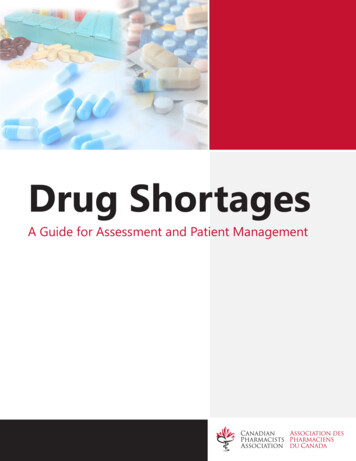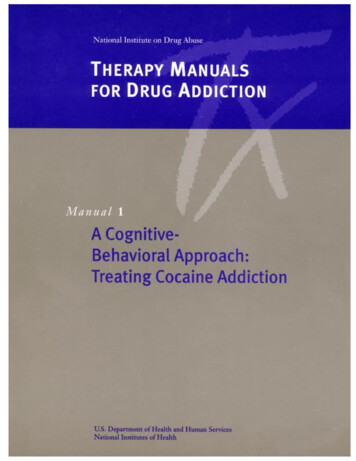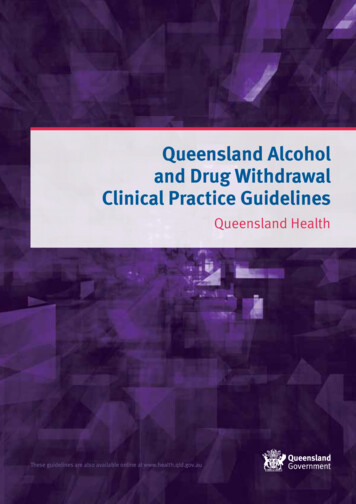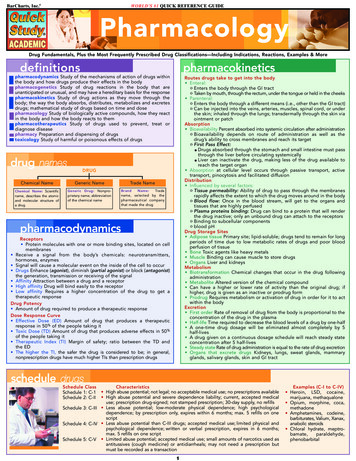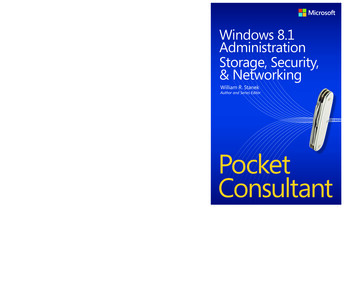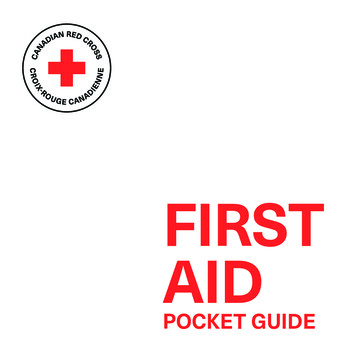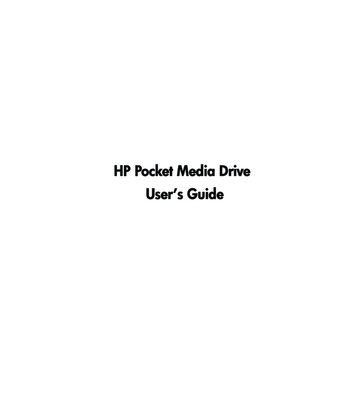
Transcription
TIPS FOR SAFE PRESCRIPTION WRITING**1. Take time to write legibly.2. Print if this would be more legible than handwriting.3. Use a typewriter or computer if necessary. Prescriptions generated by computerbased electronic medical records will eliminate legibility problems.4. Carefully print the order to avoid misreading. There are many “sound alike”drugs and medications that have similar spellings (ie, Celexa and Celebrex). Fora more extensive list, see www.edrugbook.com.5. Do not use these clinical abbreviationsThe Correct WayDo Not Usedailyqd Misinterpreted as “qid”(resulting in 4-fold overdose)qodMisinterpreted as “qid” or “qd”q other day orq48 hoursunitsProblemu or U Misinterpreted as a “0”(resulting in a 10-foldoverdose)1 mg1.0 mgDecimal point can be missed(no trailing zero) on order (resulting in a10-fold overdose)0.1 mg.1 mgDecimal point can be missed(use a leading zero) on order (resulting in a10-fold overdose)international unitsIUMisinterpreted as “IV”morphineMS, MSO4 Misinterpreted as magnesiumsulfatemagnesium sulfateMgSO4 Misinterpreted as morphinesulfate**Adapted with permission from Gomella LG, Haist SA, eds. Clinician’s PocketReference 11th Edition. New York, NY: McGraw-Hill; 2007. Based on recommendations for the use of abbreviations from the National Summit on MedicalAbbreviations hosted by The Joint Commission
CLINICIAN’S POCKETDRUG REFERENCE2015EDITORSLeonard G. Gomella, MD, FACSSteven A. Haist, MD, MS, FACPAimee G. Adams, PharmDwww.eDrugbook.comwww.thescutmonkey.comNew York Chicago San Francisco AthensLondon Madrid Mexico City Milan New DelhiSingapore Sydney Toronto
Copyright 2015 by Leonard G. Gomella. Published by McGraw-Hill Education. All rights reserved. Except as permitted under theUnited States Copyright Act of 1976, no part of this publication may be reproduced or distributed in any form or by any means, or storedin a database or retrieval system, without the prior written permission of the publisher, with the exception that the program listings maybe entered, stored, and executed in a computer system, but they may not be reproduced for publication.ISBN: 978-0-07-184001-9MHID: 0-07-184001-XThe material in this eBook also appears in the print version of this title: ISBN: 978-0-07-184000-2,MHID: 0-07-184000-1.eBook conversion by codeMantraVersion 1.0All trademarks are trademarks of their respective owners. Rather than put a trademark symbol after every occurrence of a trademarkedname, we use names in an editorial fashion only, and to the benefit of the trademark owner, with no intention of infringement of thetrademark. Where such designations appear in this book, they have been printed with initial caps.McGraw-Hill Education eBooks are available at special quantity discounts to use as premiums and sales promotions or for use incorporate training programs. To contact a representative, please visit the Contact Us page at www.mhprofessional.com.NoticeMedicine is an ever-changing science. As new research and clinical experience broaden our knowledge, changes in treatment anddrug therapy are required. The authors and the publisher of this work have checked with sources that are believed to be reliable intheir efforts to provide information that is complete and generally in accord with the standards accepted at the time of publication.However, in view of the possibility of human error or changes in medical sciences, neither the authors nor the publisher nor any otherparty who has been involved in the preparation or publication of this work warrants that the information contained herein is in everyrespect accurate or complete, and they disclaim all responsibility for any errors or omissions or for the results obtained from useof the information contained in this work. Readers are encouraged to confirm the information contained herein with other sources.For example and in particular, readers are advised to check the product information sheet included in the package of each drug theyplan to administer to be certain that the information contained in this work is accurate and that changes have not been made in therecommended dose or in the contraindications for administration. This recommendation is of particular importance in connection withnew or infrequently used drugs.TERMS OF USEThis is a copyrighted work and McGraw-Hill Education and its licensors reserve all rights in and to the work. Use of this work is subjectto these terms. Except as permitted under the Copyright Act of 1976 and the right to store and retrieve one copy of the work, you maynot decompile, disassemble, reverse engineer, reproduce, modify, create derivative works based upon, transmit, distribute, disseminate,sell, publish or sublicense the work or any part of it without McGraw-Hill Education’s prior consent. You may use the work for yourown noncommercial and personal use; any other use of the work is strictly prohibited. Your right to use the work may be terminatedif you fail to comply with these terms.THE WORK IS PROVIDED “AS IS.” McGRAW-HILL EDUCATION AND ITS LICENSORS MAKE NO GUARANTEES ORWARRANTIES AS TO THE ACCURACY, ADEQUACY OR COMPLETENESS OF OR RESULTS TO BE OBTAINED FROMUSING THE WORK, INCLUDING ANY INFORMATION THAT CAN BE ACCESSED THROUGH THE WORK VIAHYPERLINK OR OTHERWISE, AND EXPRESSLY DISCLAIM ANY WARRANTY, EXPRESS OR IMPLIED, INCLUDINGBUT NOT LIMITED TO IMPLIED WARRANTIES OF MERCHANTABILITY OR FITNESS FOR A PARTICULAR PURPOSE.McGraw-Hill Education and its licensors do not warrant or guarantee that the functions contained in the work will meet yourrequirements or that its operation will be uninterrupted or error free. Neither McGraw-Hill Education nor its licensors shall be liableto you or anyone else for any inaccuracy, error or omission, regardless of cause, in the work or for any damages resulting therefrom.McGraw-Hill Education has no responsibility for the content of any information accessed through the work. Under no circumstancesshall McGraw-Hill Education and/or its licensors be liable for any indirect, incidental, special, punitive, consequential or similardamages that result from the use of or inability to use the work, even if any of them has been advised of the possibility of such damages.This limitation of liability shall apply to any claim or cause whatsoever whether such claim or cause arises in contract, tort or otherwise.
CONTENTSEDITORSEDITORIAL BOARDPREFACEMEDICATION idotesAntimicrobial AgentsAntineoplastic AgentsCardiovascular (CV) AgentsCentral Nervous System (CNS) AgentsDermatologic AgentsDietary SupplementsEar (Otic) AgentsEndocrine System AgentsEye (Ophthalmic) AgentsGastrointestinal (GI) AgentsHematologic AgentsImmune System AgentsMusculoskeletal AgentsOB/GYN AgentsPain MedicationsRespiratory AgentsUrogenital System1112681215171717202224252627283032iii
ivContentsGENERIC AND SELECTED BRAND DRUG DATANATURAL AND HERBAL AGENTSTABLESTable 1 Local Anesthetic Comparison Chart forCommonly Used Injectable AgentsTable 2 Comparison of Systemic SteroidsTable 3 Topical Steroid PreparationsTable 4 Comparison of InsulinsTable 5 Oral ContraceptivesTable 6 Oral Potassium SupplementsTable 7 Tetanus ProphylaxisTable 8 Oral Anticoagulant Standards of PracticeTable 9 Antiarrhythmics: Vaughn Williams ClassificationTable 10 Cytochrome P–450 Isoenzymes and Common DrugsThey Metabolize, Inhibit, and InduceTable 11 SSRIs/SNRIs/Triptans and Serotonin SyndromeTable 12 Selected Multivitamin SupplementsTable 13 Influenza Vaccine Strains for 7339340342343346TIPS FOR SAFE PRESCRIPTION WRITINGInside Front CoverADULT EMERGENCY CARDIAC CARE (ECC) MEDICATIONS BASEDON 2010 AHA GUIDELINESBack Page and Inside Back Cover
EDITORSLeonard G. Gomella, MD, FACSThe Bernard W. Godwin, Jr, ProfessorChairman, Department of UrologySidney Kimmel Medical CollegeAssociate Director of Clinical AffairsSidney Kimmel Cancer CenterThomas Jefferson UniversityPhiladelphia, PennsylvaniaSteven A. Haist, MD, MS, FACPClinical ProfessorDepartment of MedicineDrexel University College of Medicine,Philadelphia, PennsylvaniaAimee G. Adams, PharmDClinical Pharmacist Specialist, Ambulatory CareAdjunct Assistant ProfessorCollege of Pharmacy and Department of Internal MedicineUniversity of Kentucky HealthCareLexington, Kentuckyv
EDITORIAL BOARDCarol L. Beck, PhDAssistant Dean, Jefferson College ofGraduate StudiesAssistant ProfessorDept. of Pharmacology &Experimental TherapeuticsThomas Jefferson UniversityPhiladelphia, PennsylvaniaGlenn R. Oettinger, PharmDClinical Pharmacist, EmergencyMedicineThomas Jefferson UniversityHospitalPhiladelphia, PennsylvaniaNick A. Pavona, MDProfessor, Department of SurgeryDivision of UrologyBenjamin Franklin UniversityMedical CenterChadds Ford, PennsylvaniaPatrick T. Gomella, MD, MPHResident Department of UrologyGeorge Washington UniversityWashington, DCTricia L. Gomella, MDPart-Time Clinical AssistantProfessor of PediatricsJohns Hopkins University School ofMedicineBaltimore, MarylandAndrew Stacy, PharmDPGY-1 Pharmacy ResidentBaptist HealthLexington, Kentuckyvi
PREFACEWe are pleased to present the 13th edition of the Clinician’s Pocket Drug Reference.This book is based on the drug presentation style originally used in 1983 in theClinician’s Pocket Reference, popularly known as the Scut Monkey Book. Our goalis to identify the most frequently used and clinically important medications, includingbranded, generic, OTC, and herbal products. The book now includes over 1400generic product listings with the true number approaching 4000 entries when specificbrand names are considered.Our unique style of presentation includes key “must-know” facts of commonlyused medications, essential for both the student and practicing clinician. The inclusion of common uses of medications rather than just the official FDA-labeled indications are based on supporting publications and community standards of care andhave been reviewed by our editors and editorial board.The limitations of difficult-to-read traditional package inserts have been recognized by the US Food and Drug Administration. Today, all newly approvedmedications provide a more user-friendly package insert. Although very useful,these summaries do not appear alongside similarly approved generic or “competing” similar products, and older medications may not have a newer user-friendlypackage insert.It is essential that students and residents in training learn more than the nameand dose of the medications they prescribe. Certain common side effects and significant warnings and contraindications are associated with almost all prescriptionmedications. Although providers should ideally be completely familiar with theentire package insert of any medication prescribed, such a requirement is unachieveable. References such as the Physician’s Desk Reference, the NIH Dailymed website, and the drug manufacturer’s web site make many package inserts readily available. While newly released medications often have a prominent presence and easyaccess to all their FDA-approved data on the web, it is often not the case of oldermedications, OTC products, or generics. Likewise, encyclopedic information can befound on certain web sites as well, and is occasionally needed when unique clinicalsituations arise. However, resources that identify the most common and essentialfacts are sometimes lacking. Our goal is to provide access to not only dosing butto these clinically significant facts and key data, whether for commonly prescribedbrand name drugs, generics, or OTC products in this pocket-sized book format.Information contained within is meant for use by healthcare professionals who arealready familiar with these commonly prescribed medications.vii
viiiPrefaceFor 2015, we have added over 60 new drugs with hundreds of changes inother medications based on recent FDA actions and manufacturers’ updates. Theseinclude deletions of discontinued brand names and compounds and many blackbox updates.Versions of this book are produced in a variety of electronic or eBook formats.Visit www.eDrugbook.com for a link to some of the electronic versions currentlyavailable. Additionally, this web site has enhanced content features such as a comprehensive listing of “look alike–sound alike” medications that can contribute toprescribing errors and other useful information related to medication prescribing.Nursing versions of this book (Nurses Pocket Drug Guide) with a sectionof customized nursing interventions is available and updated annually. An EMSguide based on this book (EMS Pocket Drug Guide) with enhanced content specifically for the field provider and emergency medical practitioner is also available.Information and links for these related publications are available on the web sitewww.eDrugbook.com.We express special thanks to our spouses and families for their long-term support of this book and the entire Scut Monkey Project (www.thescutmonkey.com).The Scut Monkey Project, launched in 1979 at the University of Kentucky Collegeof Medicine, is designed to provide new medical students and other health professional students with the basic tools needed when entering the world of hands-onpatient care. Many other schools have adopted the concept of “students teachingstudents” over the years. A type of “boot camp,” similar to our course is nowoffered to graduating medical students before they start their internships.The contributions of the members of the editorial board, and in particular, HarrietLebowitz at McGraw-Hill and Yashmita Hota at Cenveo Publisher Services, aregratefully acknowledged. As a reader, your comments and suggestions are alwayswelcome. Improvements to this and all our books would be impossible without theinterest and continual feedback of our readers. We hope this book will help youlearn some of the key elements in prescribing medications and allow you to carefor your patients in the best way possible.Leonard G. Gomella, MD, FACSPhiladelphia, PennsylvaniaLeonard.Gomella@jefferson.eduSteven A. Haist, MD, MS, FACPPhiladelphia, PennsylvaniaAimee G. Adams, PharmDLexington, Kentucky
Medication keyMedications are listed by prescribing class and the individual medications are thenlisted in alphabetical order by generic name. Some of the more commonly recognized trade names are listed for each medication (in parentheses after the genericname) or if available without prescription, noted as OTC (over-the-counter).Generic Drug Name (Selected Common Brand Names)[Controlled Substance] BOX: Summarized/paraphrased versionsof the “Black Box” precautions deemed necessary by the FDA. These aresignificant precautions, warnings, and contraindications concerning the individual medication. Uses: This includes both FDA-labeled indicationsbracketed by ** and other “off-label” uses of the medication. Becausemany medications are used to treat various conditions based on the medical literature and not listed in their package insert, we list common usesof the medication in addition to the official “labeled indications” (FDAapproved) based on input from our editorial board Acts: How the drugworks. This information is helpful in comparing classes of drugs andunderstanding side effects and contraindications. Spectrum: Specifiesactivity against selected microbes for antimicrobials Dose: Adults. Whereno specific pediatric dose is given, the implication is that this drug is notcommonly used or indicated in that age group. At the end of the dosingline, important dosing modifications may be noted (ie, take with food,avoid antacids, etc) Peds. If appropriate, dosing for children and infants isincluded with age ranges as needed W/P (Warnings and Precautions):[pregnancy/fetal risk categories, breast-feeding (as noted below)] Warnings and precautions concerning the use of the drug in specific settingsCI: Contraindications Disp: Common dosing forms SE: Common or significant side effects Notes: Other key useful information about the drug.CONTROLLED SUBSTANCE CLASSIFICATIONMedications under the control of the US Drug Enforcement Agency (DEA) (Schedules I–V controlled substances) are indicated by the symbol [C]. Most medications are“uncontrolled” and do not require a DEA prescriber number on the prescription. Thefollowing is a general description for the schedules of DEA-controlled substances:ix
xMedication KeySchedule (C-I) I: All nonresearch use forbidden (eg, heroin, LSD, mescaline).Schedule (C-II) II: High addictive potential; medical use accepted. No telephone call-in prescriptions; limit one 90 day supply; no refills. Some states requirespecial prescription form (eg, cocaine, hydrocodone, morphine, methadone).Schedule (C-III) III: Low to moderate risk of physical dependence, high risk ofpsychological dependence; prescription must be rewritten after 6 months or 5 refills(eg, acetaminophen plus codeine).Schedule (C-IV) IV: Limited potential for dependence; prescription rules sameas for schedule III (eg, benzodiazepines, propoxyphene).Schedule (C-V) V: Very limited abuse potential; prescribing regulations oftensame as for uncontrolled medications; some states have additional restrictions.FDA FETAL RISK CATEGORIESCategory A: Adequate studies in pregnant women have not demonstrated a riskto the fetus in the first trimester of pregnancy; there is no evidence of risk in thelast two trimesters.Category B: Animal studies have not demonstrated a risk to the fetus, but noadequate studies have been done in pregnant women.orAnimal studies have shown an adverse effect, but adequate studies in pregnantwomen have not demonstrated a risk to the fetus during the first trimester of pregnancy, and there is no evidence of risk in the last two trimesters.Category C: Animal studies have shown an adverse effect on the fetus, but noadequate studies have been done in humans. The benefits from the use of the drugin pregnant women may be acceptable despite its potential risks.orNo animal reproduction studies and no adequate studies in humans have been done.Category D: There is evidence of human fetal risk, but the potential benefitsfrom the use of the drug in pregnant women may be acceptable despite its potentialrisks.Category X: Studies in animals or humans or adverse reaction reports, or both,have demonstrated fetal abnormalities. The risk of use in pregnant women clearlyoutweighs any possible benefit.Category ?: No data available (not a formal FDA classification; included toprovide complete dataset).BREAST-FEEDING CLASSIFICATIONNo formally recognized classification exists for drugs and breast-feeding. This shorthand was developed for the Clinician’s Pocket Drug Reference. M ?/–?Compatible with breast-feedingMonitor patient or use with cautionExcreted, or likely excreted, with unknown effects or at unknown concentrationsUnknown excretion, but effects likely to be of concernContraindicated in breast-feedingNo data available
ABBREVIATIONSD: change?: possible or uncertain : check, follow, or monitor : decrease/decreased : increase/increased : not equal to; not equivalent to : dividedµM: symbol for micromolarAb: antibody, abortionabbrev: abbreviationAbd: abdominalABG: arterial blood gasABMT: autologous bone marrowtransplantationabn: abnormalABSSSI: Acute bacterial skin and skinstructure infectionsabx: antibioticsac: before meals (ante cibum)ACE: angiotensin-converting enzymeACH: acetylcholineACIP: American College ofInternational Physicians; AdvisoryCommittee on ImmunizationPracticesACLS: advanced cardiac life supportACS: acute coronary syndrome,American Cancer Society, AmericanCollege of SurgeonsACT: activated coagulation timeActs: Action(s)ADH: antidiuretic hormoneADHD: attention-deficit hyperactivitydisorderADR: adverse drug reactionADT: androgen deprivation therapyAED: anti-epileptic drugAF: atrial fibrillationAGEP: acute generalizedexanthematous pustulosisAHA: American Heart AssociationAKA: also known asalk phos: alkaline phosphataseALL: acute lymphocytic leukemiaALT: alanine aminotransferaseAMI: acute myocardial infarctionAML: acute myelogenous leukemiaamp: ampuleANA: antinuclear antibodyANC: absolute neutrophil countantag: antagonistAPACHE: acute physiology andchronic health evaluationAPAP: acetaminophen[N-acetyl-p-aminophenol]aPTT: activated partial thromboplastintimeARB: angiotensin II receptor blockerARDS: adult respiratory distresssyndromeARF: acute renal failureAS: aortic stenosisASA: aspirin (acetylsalicylic acid)ASAP: as soon as possibleAST: aspartate aminotransferaseATE: arterial thrombotic eventATP: adenosine triphosphateattn: attentionatyp: atypicalAUB: abnormal uterine/vaginal bleedingAUC: area under the curveAV: atrioventricularxi
xiiAVM: arteriovenous malformationBBB: bundle branch blockBCL: B-cell lymphomaBCP: birth control pillsbid: twice dailybili: bilirubinBM: bone marrow, bowel movement BM: bone marrow suppression,myelosuppressionBMD: bone mineral densityBMI: body mass indexBMT: bone marrow transplantationBOO: bladder outlet obstructionBP: blood pressure BP: hypotension BP: hypertensionBPH: benign prostatic hyperplasiaBPM: beats per minuteBS: blood sugarBSA: body surface areaBUN: blood urea nitrogenCa: calciumCA: cancerCABG: coronary artery bypass graftCAD: coronary artery diseaseCAP: community-acquired pneumoniacaps: capsulecardiotox: cardiotoxicityCBC: complete blood countCCB: calcium channel blockerCCR5: human chemokine receptor5; HIV attaches to the receptor toinfect CD4 T cellsCDAD: Clostridium difficile-associated diarrheaCDC: Centers for Disease Control andPreventionCF: cystic fibrosisCFCs: chlorofluorocarbonsCFU: colony-forming unitsCHD: coronary heart diseaseCHF: congestive heart failurechol: cholesterolAbbreviationsCI: contraindicatedCIDP: chronic inflammatorypolyneuropathyCIWA: Clinical Institute WithdrawalAssessment Score; used to monitorEtOH withdrawalCJD: Creutzfeldt-Jakob diseaseCK: creatinine kinaseCKD: chronic kidney diseaseCLL: chronic lymphocyticleukemiaCML: chronic myelogenousleukemiaCMV: cytomegalovirusCNS: central nervous systemcombo: combinationcomp: complicatedconc: concentrationcond: conditioncont: continuousCOPD: chronic obstructive pulmonarydiseaseCOX: cyclooxygenaseCP: chest painCPP: central precocious pubertyCR: controlled releaseCrCl: creatinine clearanceCRF: chronic renal failureCRPC: castrate-resistant prostatecancerCSF: cerebrospinal fluidCV: cardiovascularCVA: cerebrovascular accident,costovertebral angleCVH: common variablehypergammaglobulinemiaCXR: chest x-rayCYP: cytochrome P450 enzymeD: diarrhead: dayDA: dopamineDBP: diastolic blood pressureD/C: discontinue
AbbreviationsDDP-4: dipeptidyl peptidase-4derm: dermatologicD5LR: 5% dextrose in lactated RingersolutionD5NS: 5% dextrose in normalsalineD5W: 5% dextrose in waterDHT: dihydrotestosteroneDI: diabetes insipidusDIC: disseminated intravascularcoagulationDisp: dispensed as; how the drug issuppliedDKA: diabetic ketoacidosisdL: deciliterDM: diabetes mellitusDMARD: disease-modifyingantirheumatic drug; refers to drugsin randomized trials to decreaseerosions and joint space narrowingin rheumatoid arthritis (eg,methotrexate, azathioprine)DN: diabetic nephropathyDOT: directly observed therapy (usedfor TB treatment)DR: delayed releaseDRESS: drug rash with eosinophiliaand systemic symptomsd/t: due toDTap: Diptheria toxinDVT: deep venous thrombosisDz: diseaseEC: enteric coatedECC: emergency cardiac careECG: electrocardiogramED: erectile dysfunctionEE: erosive esophagitiseGFR: estimated glomerular filtrationrateEGFR: epidermal growth factorreceptorEIB: exercise-inducedbronchoconstrictionxiiiELISA: enzyme-linkedimmunosorbent assayEL.U.: ELISA unitEMG: electromyelogramEMIT: enzyme-multipliedimmunoassay testepi: epinephrineEPS: extrapyramidal symptoms(tardive dyskinesia, tremors andrigidity, restlessness [akathisia],muscle contractions [dystonia],changes in breathing andheart rate)ER: extended releaseESA: erythropoiesis-stimulating agentsESR: erythrocyte sedimentation rateESRD: end-stage renal diseaseET: endotrachealEtOH: ethanolextrav: extravasationfam: familyFAP: familial adenomatous polyposisFe: ironFLP: fasting lipid profileFMF: familial Mediterranean feverFSH: follicle-stimulating hormone5-FU: fluorouracilFxn: functiong: gramGABA: gamma-aminobutyric acidGBM: glioblastoma multiformeGC: gonorrheaG-CSF: granulocyte colonystimulating factorgen: generationGERD: gastroesophageal reflux diseaseGF: growth factorGFR: glomerular filtration rateGHB: gamma-hydroxybutyrateGI: gastrointestinalGIST: gastrointestinal stromal tumorGLP-2: glucagon-like peptide-2glu: glucose
xivGM-CSF: granulocyte-macrophagecolony-stimulating factorGnRH: gonadotropin-releasinghormoneG6PD: glucose-6-phosphatedehydrogenasegtt: drop, drops (gutta)GU: genitourinaryGVHD: graft-versus-host diseaseh: hour(s)H1N1: swine flu strainHA: headacheHAE: hereditary angioedemaHAP: hospital acquired pneumoniaHBsAg: hepatitis B surface antigenHBV: hepatitis B virusHCL: hairy cell leukemiaHCM: hypercalcemia of malignancyHct: hematocritHCTZ: hydrochlorothiazideHD: hemodialysisHDL-C: high-density lipoproteincholesterolheme: hematologichep: hepatitishepatotox: hepatotoxicityHFA: hydrofluroalkane chemicals;propellant replacing CFCs in inhalersHFSR: hand-foot skin reactionHgb: hemoglobinHGH: human growth hormoneHIT: heparin-inducedthrombocytopeniaHITTS: heparin-induced thrombosisthrombocytopenia syndromeHIV: human immunodeficiencyvirusHMG-CoA: hydroxymethylglutarylcoenzyme Ah/o: history ofHP: high potencyHPV: human papillomavirusHR: heart rateAbbreviations HR: increased heart rate(tachycardia)hs: at bedtime (hora somni)HSCT: hematopoietic stem celltransplantationHSV: herpes simplex virus5-HT: 5-hydroxytryptamineHTN: hypertensionHx: history ofhypersens: hypersensitivityIBD: irritable bowel diseaseIBS: irritable bowel syndromeIBW: ideal body weightICP: intracranial pressureIFIS: intraoperative floppy iris syndromeIg: immunoglobulinIGF: insulin-like growth factorIHSS: idiopathic hypertropic subaorticstenosisIL: interleukinIM: intramuscularimpair: impairmentin: inchesInf: infusioninflam: inflammationInfxn: infectionInh: inhalationINH: isoniazidinhal: inhalationinhib: inhibits, inhibitor(s)Inj: injectionINR: international normalized ratioINSTI: integrase strand transferinhibitorInsuff: insufficiencyInt: internationalintol: intolerenceIntravag: intravaginalIO: intraosseousIOP: intraocular pressureIR: immediate releaseISA: intrinsic sympathomimeticactivity
AbbreviationsIT: intrathecalITP: idiopathic thrombocytopenicpurpuraInt units: international unitsIUD: intrauterine deviceIV: intravenousJME: juvenile myoclonic epilepsyJRA: juvenile rheumatoid arthritis(SJIA now preferred)jt: jointK: klebsiellaK : potassiumL&D: labor and deliveryLA: long-actingLABA: long-acting beta2-adrenergicagonistsLAIV: live attenuated influenza vaccineLDL: low-density lipoproteinLFT: liver function testLH: luteinizing hormoneLHRH: luteinizing hormone-releasinghormoneliq: liquid(s)LMW: low molecular weightLP: lumbar punctureLR: lactated ringersLVD: left ventricular dysfunctionLVEF: left ventricular ejection fractionLVSD: left ventricular systolicdysfunctionlytes: electrolytesMAC: Mycobacterium aviumcomplexmaint: maintenance dose/drugMAO/MAOI: monoamine oxidase/inhibitormax: maximummcg: microgram(s)mcL: microliter(s)MDD: major depressive disorderMDI: multidose inhalerMDS: myelodysplasia syndromemeds: medicinesxvmEq: milliequivalentmet: metastaticmg: milligram(s)Mg2 : magnesiumMgOH2: magnesium hydroxideMI: myocardial infarction, mitralinsufficiencymill: millionmin: minute(s)mL: milliliter(s)mo: month(s)MoAb: monoclonal antibodymod: moderateMRSA: methicillin-resistantStaphylococcus aureusMS: multiple sclerosis,musculoskeletalms: millisecond(s)MSSA: methicillin-sensitiveStaphylococcus aureusMTC: medullary thyroid cancerMTT: monotetrazoliumMTX: methotrexateMyG: myasthenia gravisN: nauseaNA: narrow angleNAG: narrow angle glaucomaNCI: National Cancer Institutenephrotox: nephrotoxicityneurotox: neurotoxicityng: nanogram(s)NG: nasogastricNHL: non-Hodgkin lymphomaNIAON: nonischemic arterial opticneuritisnl: normalNO: nitric oxideNPO: nothing by mouth (nil per os)NRTI: nucleoside reverse transcriptaseinhibitorNS: normal salineNSAID: nonsteroidal antiinflammatory drug
xviNSCLC: non-small cell lung cancerNSR: normal sinus rhythmNSTEMI: non-ST elevationmyocardial infarctionN/V: nausea and vomitingN/V/D: nausea, vomiting, diarrheaNYHA: New York Heart AssociationOA: osteoarthritisOAB: overactive bladderobst: obstructionOCD: obsessive compulsive diseaseOCP: oral contraceptive pillOD: overdoseODT: orally disintegrating tabletsoint: ointmentOK: recommendedONJ: osteonecrosis of jawop: operativeophthal: ophthalmicOSAHS: obstructive sleep apnea/hypopnea syndromeOTC: over-the-counterototox: ototoxicityoz: ouncesPABA: para-aminobenzoic acid(4-aminobenzoic acid)PAT: paroxysmal atrial tachycardiapc: after eating ( post cibum)PCa: cancer of the prostatePCC: Prothrombin ComplexConcentratePCI: percutaneous coronaryinterventionPCN: penicillinPCP: Pneumocystis jiroveci (formerlycarinii) pneumoniaPCWP: pulmonary capillary wedgepressurePDE: phosphodiesterasePDE5: phosphodiesterase type 5PDGF: platelet-derived growth factorPE: pulmonary embolus, physicalexamination, pleural effusionAbbreviationsPEA: pulseless electrical activityPEG: polyethylene glycolperf: perforationPFT: pulmonary function testpg: picogram(s)PGE-1: prostaglandin E-1P-gp: P-glycoprotein (membrane drugtransporter)PGTC: primary generalizedtonic-clonic (PGTC)Ph: Philadelphia chromosomePheo: pheochromocytomaphotosens: photosensitivityPI: product insert (package label)PID: pelvic inflammatory diseasepkg: packagePKU: phenylketonuriaplt: plateletPMDD: premenstrual dysphoric disorderPML: progressive multifocalleukoencephalopathyPMS: premenstrual syndromePO: by mouth (per os)POME: pulmonary microembolismPPD: purified protein derivativePPI: proton pump inhibitorP
This book is based on the drug presentation style originally used in 1983 in the . For 2015, we have added over 60 new drugs with hundreds of changes in . prescribing errors and other useful information related to medication prescribing. Nursing versions of this book (Nurses Poc


